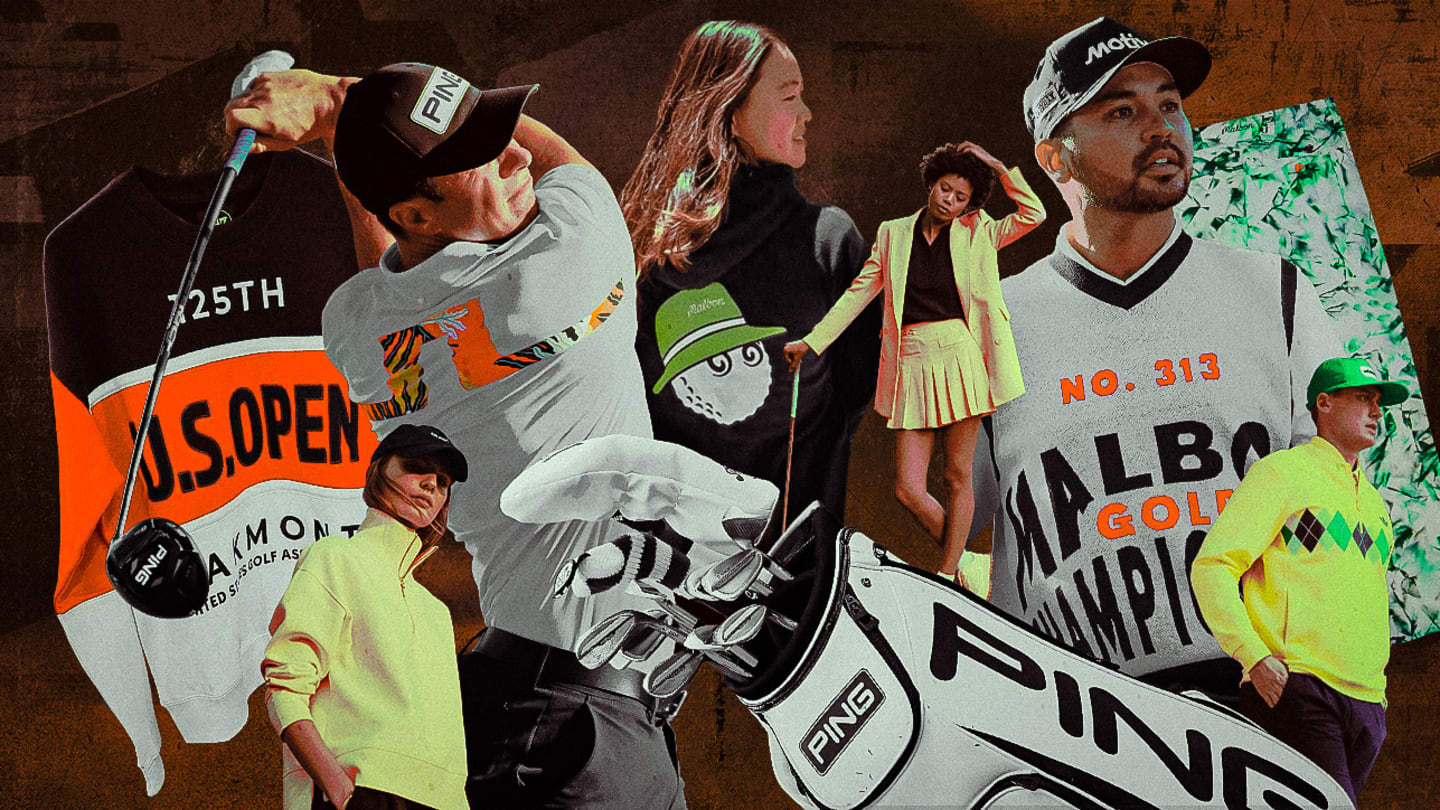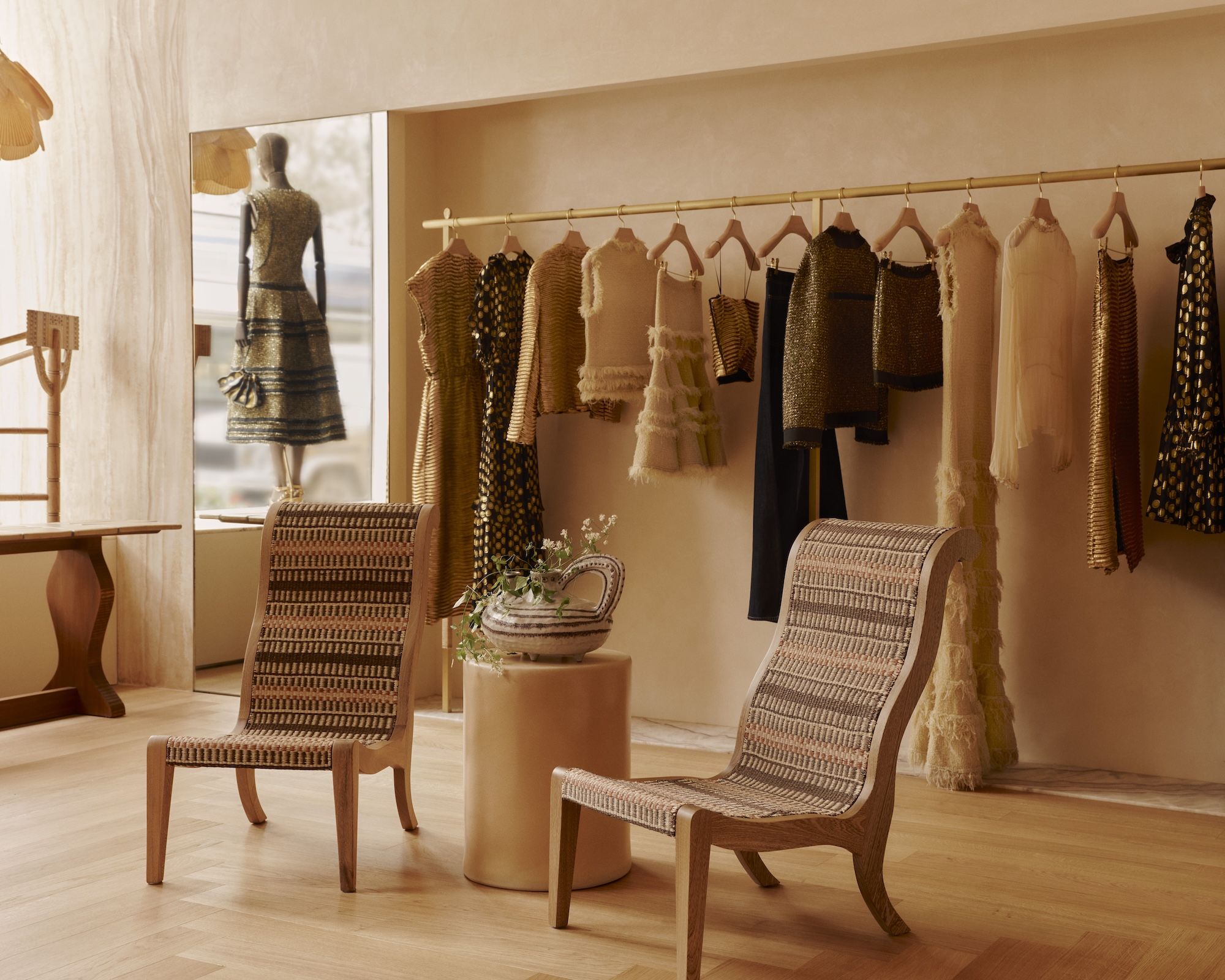A marine layer and steady drizzle hung in the placid air over Pacific Dunes golf course. Black-on-black rain gear dominated the misty scene with one exception—a pair of green, black, and white graffiti rain pants made by Malbon.
“Those look good,” Pacific Dunes head golf professional Jason Poll says. “It beats all the blacks and blues I usually see.”
Never a golf fashionista, it took some persuading to don these billowy, bold rain pants inspired by graffiti artist Futura and produced by Malbon, a golf and lifestyle fashion brand known for pushing the boundaries of what’s acceptable on the course. Just ask Augusta National (more on that shortly).
I’d never worn anything like these on the street, let alone on a course. Slacks and polos were my go-to. That’s what I was told was acceptable. That’s what I believed for 20 years.
Then I found myself on the first tee at one of the top public golf course in the country, where I received compliments from the 60-something starter on my “awesome pants” and it struck me: the old norms of golf apparel are fading into oblivion as a new wave takes over.
“Golf is not a sport where you need a specific uniform,” says Marty Hackel, the former Fashion Director at Golf Digest. “We’re seeing a lot more companies giving you a product that is practical and versatile. You can wear it on the course and you can wear it off the course. That’s how it should be.”
What a freeing thought.
For roughly 70 years, golf did have a uniform. Ill-fitted trousers and polyester polos for men. Skirts or pants and a shrunken version of a men’s polo for women.
Bright colors and funky prints were avenues to stand out. So were the various headwear options – visors, flat caps, straw hats, fedoras, bucket hats, and, of course, the standard baseball cap.
Maybe you threw in a colorful ball or a black glove. Most stuck with white.
No matter the combination, no matter the colors, you knew it when you saw it on the street—this person either just played golf or was going to play now.
“I’m not into the uniform thing where you have to fit into this box,” says Stephen Malbon, who co-founded Malbon with his wife Erica in 2017. “The last thing young people want to do is be told 8,000 rules before they go and do something. It’s more important for the growth of the game to be comfortable to go and play golf.”
That is the basis of the rapid transformation golf fashion has undergone over the last few years. Golf apparel is now lifestyle apparel. If you like fishing and golf, there’s something you can wear for both. If you like upscale dinners and golf, they’ve got you there too. Want to work out before or after a round? You can wear one outfit for both.
The lines between what you wear on the course and off are blurring. This is by design.
“I couldn’t bear to wear this costume I had to put on to play golf. I wanted something more versatile,” says Amy Anderson, co-Founder and CMO of Honors, a women’s golf and lifestyle apparel company. “I used to shove my golf clothes in the back of the closet with no other purpose in my life when I was done playing, but I wanted to have something I could pull out of my closet and play golf in and also wear with jeans to dinner.”
Some of the changes in golf fashion are more prominent—hoodies instead of quarter-zips, joggers instead of slacks, sneakers instead of spikes. Some are more subtle, like cotton instead of polyester, monotone instead of neon, solids instead of prints.
Some seem destined to be fads, like big letter hats and giant logos. Some could withstand the test of time, especially well-tailored pieces that are interchangeable with a daily wardrobe.
All is designed to combine golf and fashion with daily life.
Golf is, after all, merely a piece of who you are. It’s not the whole thing. The clothes you wear on the course should be an extension of who you are off it, and vice versa. They should function in both settings.
“Everything has been elevated to this multifunctional, multipurpose realm of fashion,” says Jessica Marksbury, a senior editor at Golf.com, who covers golf fashion among other subjects. “That’s what people are responding to and appreciating. They’re no longer buying golf clothes just to play golf. They’re buying clothes they can play golf in and then go to the gym or dinner. People are more willing to make a significant investment because it’s more transitional.”
An easy place to observe the change in golf fashion is at the U.S. Open merchandise tent at Oakmont Country Club this week. Long a bastion of traditionalism, the USGA has embraced the new era of golf fashion. The results have been increased sales at the U.S. Open and U.S. Women’s Open over the last three years. The same should hold true at Oakmont, where competition tickets are sold out.
High-end sky blue hoodies from Peter Millar mingle with black and yellow U.S. Open hockey jerseys. A ’47 Brand red, white and blue crewneck sweater with massive U.S. Open and Oakmont lettering is offset by a minimalist G/FORE navy t-shirt with Oakmont’s famed church pew bunkers on the back.
New school meets old school. Showy meets simplicity. There’s something for everyone’s lifestyle.
“When people come to shop, they’re not just shopping for golf anymore. They’re shopping for their everyday life,” says USGA managing director of merchandise and licensing Mary Lopuszynski. “Historically, we’re having these high average transactions because people are buying things they will wear to dinner and to golf. It’s not just for golf anymore.”
The same is true at USGA headquarters in Liberty Corner, N.J. Lopuszynski used to have a separate outfit for work, then she would for the golf course, then she would for her personal life. Now her outfits flow more seamlessly with her lifestyle. Even USGA CEO Mike Whan wears hoodies to the office now.
“We have seen some significant changes over the last few years,” Lopuszynski says. “The designers are getting more sophisticated and subtle. Floral has slowed down. Hoodies came in. 10 years ago, we barely sold any hoodies, and now sales are through the roof. It’s so much more casual now, which is why things are changing.”
Even Augusta National’s merchandise offering has evolved. Pink hats with AZAELA and orange hats with PIMENTO emblazoned in bold letters were popular purchases this year. Simplistic “Masters Tournament” hoodies are perfect for fall days by the fire. Even the ballyhooed gnomes represent a lifestyle offering for those who love to garden and golf.
Some may view these changes as trivial. In a sport where tradition reigns supreme and stylish players like Justin Thomas were mocked for wearing joggers and hoodies five years ago, however, they represent a massive paradigm shift.
Women’s apparel has also seen a significant increase in attention. Brands like Honors, A. Putnam and Williams Athletic Club are leading the evolution.
Simple, flattering silhouettes with earthy colors. Upscale fabrics emphasizing comfortable performance. No logos. Minimalism and versatility. You’d have no problem transitioning their garments from a course to a boardroom to a kid’s soccer game to a restaurant.
All three exclusively produce apparel for women. This aren’t men’s companies altering the sizing and colors and throwing some ruffles on the sleeves for women. This is for women by women with lifestyle and golf center stage.
“I’ve had women say they don’t play golf because they can’t find anything to wear,” Anderson says. “We can’t have that. That breaks my heart. That’s why we try and create something that women can feel good in and they feel confident in the performance as well.”
Anderson and her co-founders, Huntley Rodes and Jenna Walter, are helping fill that void at an opportune time.
According to the National Golf Foundation, the total number of female golfers rose to a record 7.9 million in 2024. That was the fifth straight year in which the number of female golfers increased. Women now represent 28% of total golfers, another record.
One way Honors is trying to stand out from the growing competition is by injecting more modern fashion trends into its apparel.
“Golf is usually two years behind fashion. I would love to see those things catch up,” Anderson says. “There were elements at Paris fashion week this year that I’m hoping we can implement and have ready for fall and spring 2026.”
Malbon has been a pioneer in closing the gap between golf, fashion, pop culture and lifestyle. They’ve collaborated with Futura, Jimmy Choo, Footjoy, Adidas, New Balance, Prince and even Curb Your Enthusiasm. The results are a new and invigorating look at golf fashion, one unencumbered by the shackles of tradition.
“Thank god we have people like Stephen Malbon who want to push golf fashion forward,” Hackel says. “We need brands like Malbon and Greyson and Field Day Sporting Co. that take a fresh look at golf apparel. It doesn’t mean you have to do wild, off-the-wall stuff. Stephen sometimes goes a little too far, but he’s doing it to prove a point.”
That point isn’t to upset members at Augusta National by outfitting Jason Day with a grandiose Malbon vest he’s asked to take off, as was the case during the 2024 Masters. The point is to break down barriers and provide new avenues for people to feel comfortable playing golf.
“I want to show young creative people that the old guard is not as stuck up and yuppie as they may think and show the old guard that young creative people aren’t as wild or radical as they may think,” Malbon says. “The golf course doesn’t care where you’re from or how much money you make or who you voted for. All that matters is: can you get the ball in the hole quickly? That’s all golf cares about. We want to inspire new people to check out golf and knock out some of the preconceived negative thoughts they may have.”
Fashion is that avenue and Malbon continues to push that envelope.
Malbon recently announced a new collaboration with GAP featuring Jesper Parnevik, one of the more bombastic trendsetters in golf fashion history. Unlike the flipped-up brim, neon colors and wild prints of Parnevik’s past, however, the Malbon-Gap collaboration is more subtle, featuring plenty of classic solid colors and some plaid splashed in around the word PAR, which plays off the classic GAP logo.
Their collaborations with Futura and Jimmy Choo produced swanky, stylish garments previously foreign to the game of golf. Yet they’re being embraced by a new demographic of player critical for the future of the game.
“Younger people are definitely in that more casual zone,” Marksbury says. “Malbon is a great example. Some of their stuff is super high fashion, super cutting edge. You would never equate that with golf, even five or 10 years ago. But brands like Malbon embracing that is a great development for the game.”
Golf and fashion have always been intertwined. Ben Hogan and Arnold Palmer were simplistically chic. Parnevik and John Daly were grandiose risk takers. Tiger Woods was pure power.
Through their eras, however, golf apparel scarcely evolved. Different colors, different prints, different fabrics, different accessories. Mock collars and parachute pants notwithstanding, little about the golf uniform matured.
Until now.
“There’s always been fashion in golf,” Hackel says. “When people do things that are noteworthy, we talk about them. When they do things out of the norm, we accept it. The companies that have big investments in golf have a responsibility to keep it fresh and to keep it innovative. It’s great seeing many of them doing that now.”


